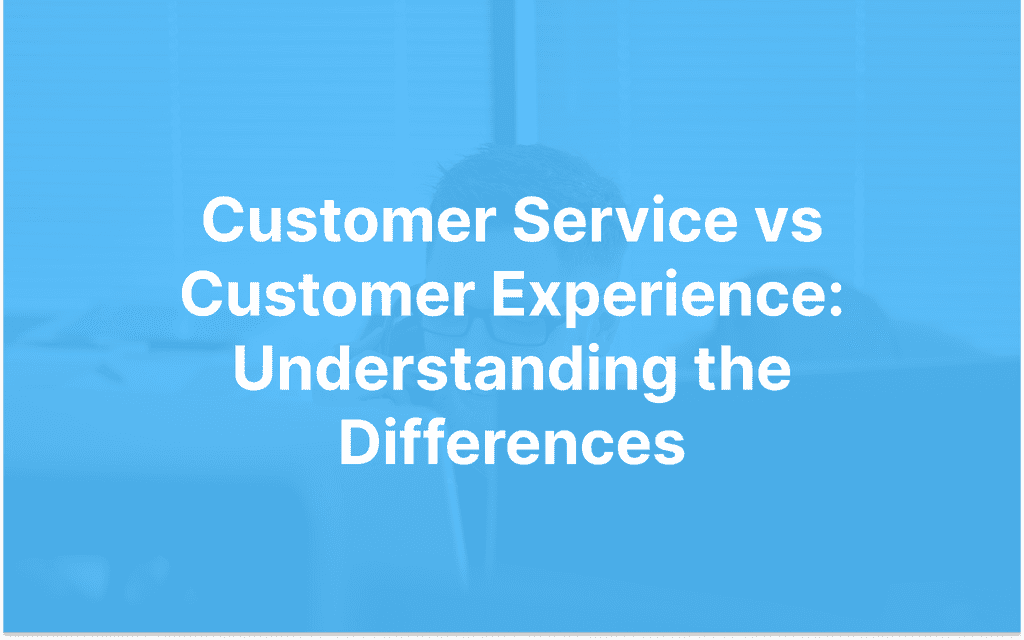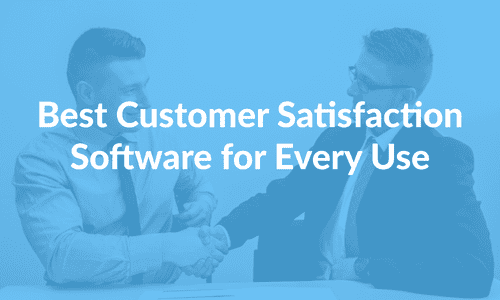Customer service vs. customer experience: do you know the difference? They’re often used interchangeably, but they’re different concepts.
To give your customers positive customer service and customer experience, it’s useful to get to the heart of these two terms and their meanings. This way, you can develop separate strategies for each, with a clear purpose.
Customerly enables SaaS businesses to provide excellent customer service and customer experiences. Whether you’re onboarding new clients with automated onboarding emails or nurturing a lead by offering live chat support, the platform allows you to automate customer communications and be there exactly when your customer needs you.
Today, we’re going to dive into customer service vs customer experience. By the end of this article, you’ll have a firm grasp of both terms to help you with your customer interactions.
Customer Service vs Customer Experience: Overview
- Customer service is all about helping customers with their queries and questions, solving problems, and demonstrating how to use your products and services. Various tools that facilitate customer service often offer analytics to help improve customer service.
- Customer experience, on the other hand, is a broad term that describes the customer’s impression of your business throughout their customer journey. It’s how they think and feel about their experience with you at each stage. You can use surveys as a proxy measure reflecting the customer experience. These include Net Promoter Score (NPS) and Customer Effort Score surveys.
CES survey template
With these in mind, great customer service improves customer experience. When you swiftly reply to messages, solve issues, and action feedback, your customers will end up having a better experience with your business.
Even something as small as a welcome message when a user enters your website, or something larger like an onboarding session all contribute towards a positive experience for your customer.
Key takeaways:
- Customer service is about helping the customer and making their dealings with your company smooth. It’s something you actively do.
- Customer experience describes the impact that your various business activities have on the customer. It’s something you can influence.
- Customer service is one aspect that can impact customer experience, but there are many more.
What is Customer Service?
Customer service refers to the direct contact a customer has with your brand. This could be a member of your customer service team, a chatbot, or even a SaaS helpdesk that can point users in the right direction. Using a customer service platform like Customerly helps you effectively engage with your customers whenever they need help through the features we’ve just mentioned.
At the same time, you can also uncover valuable insights relating to customer service performance, such as the number of queries you have over time, the response rate of your individual team members, and the average time to first reply. Tracking these help ensure that customers are being catered to as effectively as your team can:
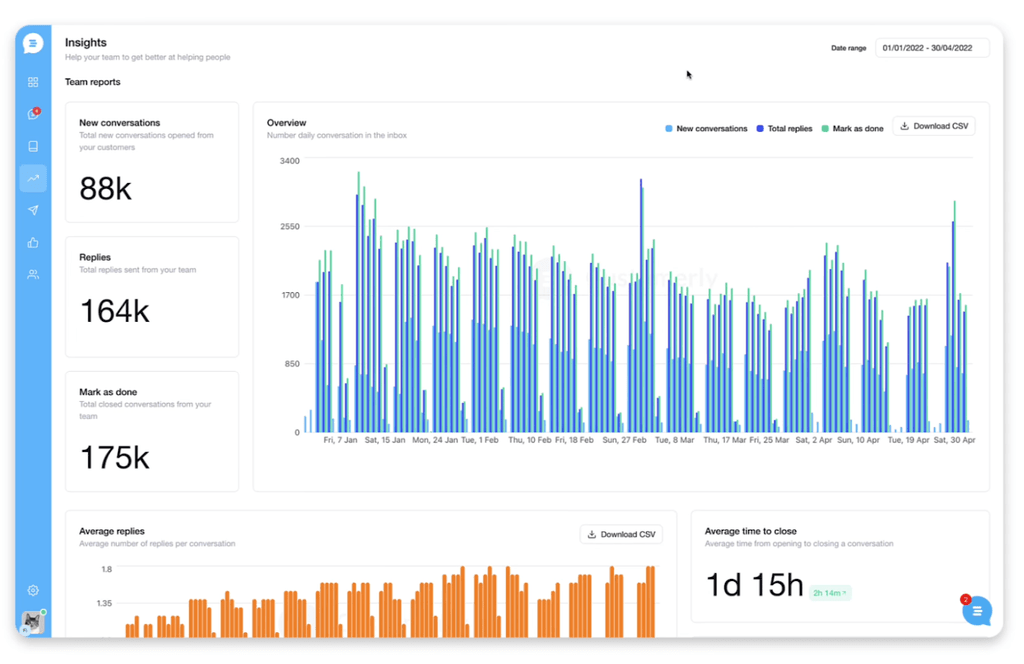
Why is customer service important?
Customer service is a valuable contribution to the overall customer experience.
According to 123 Form Builder, 81% of customers say that good customer service influences them to make a purchase. 90% of customers also claim that they’re likely to spend more money with a company if their customer service is personalized.
These statistics indicate there is a strong link between providing customers with good customer service and the customer spending more money. This, of course, means higher revenue for businesses.
Beyond that, though, data garnered from customer service channels, like email inboxes, lets you understand how customers feel about your products, services, and brand. It can highlight issues within your processes that might be hindering your progress.
For example, you might get a lot of queries about using a specific feature of your software. Knowing this, you can develop resources like webinars and articles dedicated to addressing how to use it. You can then either instruct your chatbot to direct customers to these resources quickly when they query it, or you can email this information directly to customers.
Types of Customer Service
Customer service comes in all shapes and forms. Customerly customers, for example, enjoy how the Customerly helpdesk integrates with their CRM, something Tweet Hunter noted when they partnered with us. This means they can access everything from one central location without needing to switch between applications.
Let’s go through the types of customer service you can provide and manage with Customerly and other customer experience management software:
Live Chat Customer Service
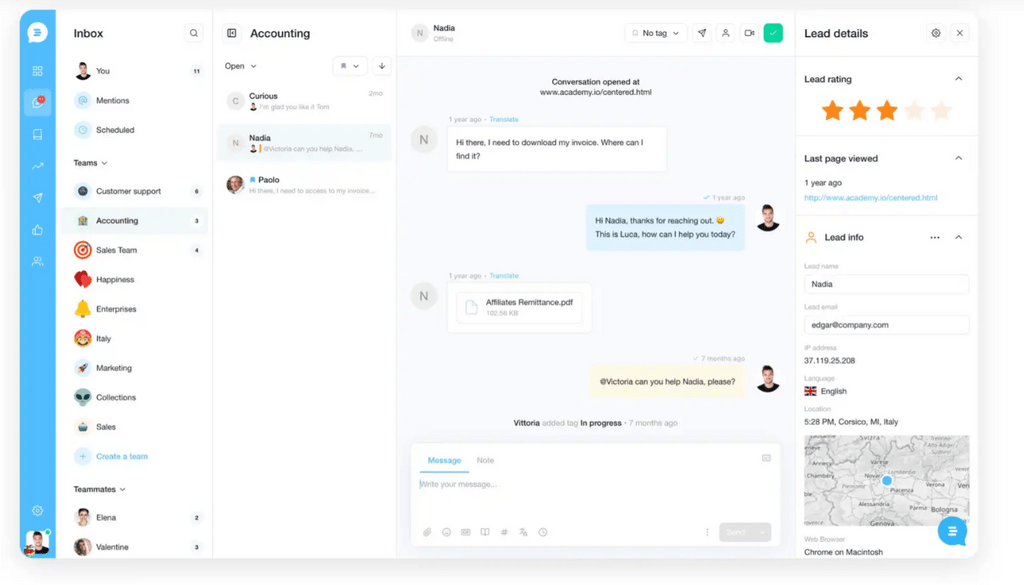
Live chat provides a quick and easy way for customers to get answers to their questions without having to leave your website or app.
Live chats can be hosted by customer service reps, AI, or both. In the case of AI, chatbots can be programmed to give automated responses to common questions without the need to get a rep involved. This results in quick resolution times and allows reps to concentrate on more complex issues.
Live chat is also preferable to telephone communication. According to statistics, 73% of consumers feel they get the most satisfactory results with live chat compared to 44% of consumers who think phone support is the best. These figures are continuously changing, and with the ever-expanding capabilities of AI, it’s safe to say the adoption of live chat will likely increase even more as time goes on.
For an example of live chat in action, consider a SaaS customer who is still deciding on whether to buy a subscription or not. They’re still weighing up other options. In this case, you can apply a live chat trigger to ask if the customer needs any help after a certain amount of time. They can then ask any questions they have and feel in a better position to make the purchase.
This is an example of live chat providing a good level of customer service.
A subset of chat support could also happen on social media. This is especially important for businesses that have a large presence on platforms such as Twitter, LinkedIn, Instagram and Facebook.
Because of the multidirectional nature of live chat support, Customerly also has a unified inbox to centralize all live chat interactions:
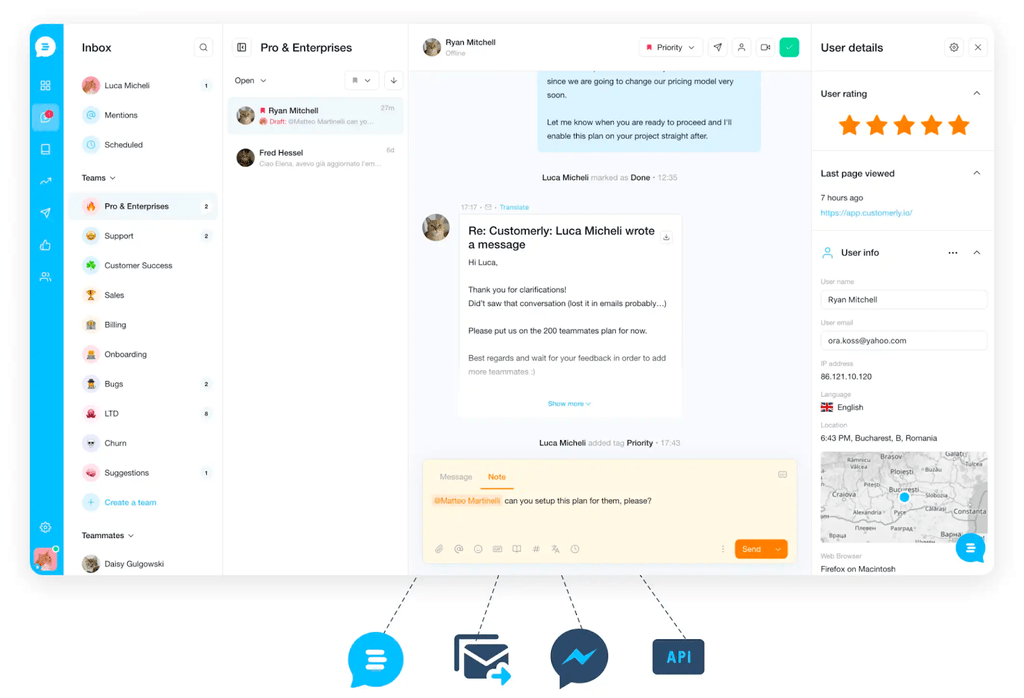
Email support
We all know what email support is. The customer opens a ticket with a query or sends an email to a dedicated customer support email address. This could be a question, complaint, or general feedback about their experience.
While it’s good practice to send automated emails upon receipt of a customer contacting email support, if a customer is choosing to email you rather than using your chatbot, it might be because they want a more thorough response than a chatbot can provide.
An email management software could help you organize your incoming emails according to priority and even assign emails to reps and other members of staff. If your customer wants to escalate a complaint, for example, you can easily get a manager involved by simply CC-ing them into the emails.
Video Chat

Video chat is a more personalized way of providing customer service. Some people prefer to see the person they’re communicating with because it helps them see visual cues and match facial expressions to what the other person is saying. Interestingly, research has suggested that 55% of communication is non-verbal, which would explain the preference for seeing the person you’re speaking with.
While video chat support is not yet up there with live chat in terms of widespread application, it might become utilized in the future because of the preference for a more personalized experience. That’s why Customerly advocates for this type of customer service. Our software facilitates live HD video support so you can chat with customers in real time and discuss your services as if you were there in person.
What is Customer Experience?
Customer experience refers to how your actions make the customer feel about your brand. In other words, the impression they have of your brand throughout their interactions with you, such as when contacting customer service, browsing your website, and watching your advertisements. It includes everything from the start of their journey right through to sign-up and beyond.
It encompasses every aspect of a business, like ease of use, quality of service, personalization… you name it! And getting it right is crucial, as delivering a poor customer experience won’t just affect your company’s reputation; it’ll affect your bottom line. But, you’ll need to communicate with your users to actually gain insight into the customer experience.
That’s why customer service and customer experience are so closely related, as teams can identify issues from user complaints and develop solutions for any problems they face. That being said, you can gather data through in-app surveys, questionnaires, and live chats (which you can find on the Customerly platform), allowing you to proactively fix any issues before your users have to contact your CS team.
Why is Customer Experience Important?
Whether you’re a SaaS or any other sort of business, providing a superior customer experience can help you get ahead of the competition. And the numbers speak for themselves:
- Increase retention. According to Harvard Business Review, retention is 25x less costly than acquisition. Having a great customer experience is key to long-term customers
- Increase word-of-mouth referrals. According to Esteban Kolsky, 72% of happy customers refer you to 6 people or more. Conversely, unhappy customers share their experience with 15 people or more.
- Social proof generation. Your online reputation is your personal moat. Social proof is the only thing that your competitors can’t replicate (or they’d risk getting sued). Having a great customer experience will lead to better chances of scoring a glowing testimonial or having the customer write a review on a site like G2 or Capterra. Having testimonials, reviews, case studies, and other social proof elements will lead to higher conversions (especially when you include them in your website).
Gathering Customer Experience Insights
Customer support is relatively easy to quantify. As we have mentioned earlier, customer support platforms today have reporting analytics and dashboards that make it easy to assess if you’re doing a good job servicing your customers.
On the other hand, customer experience is a bit more vague and nebulous. That said, there are good proxy indicators to assess customer experience, such as:
- Net Promoter Score (NPS) surveys. This assesses how loyal your customers are to your service on a scale of 1 to 10.
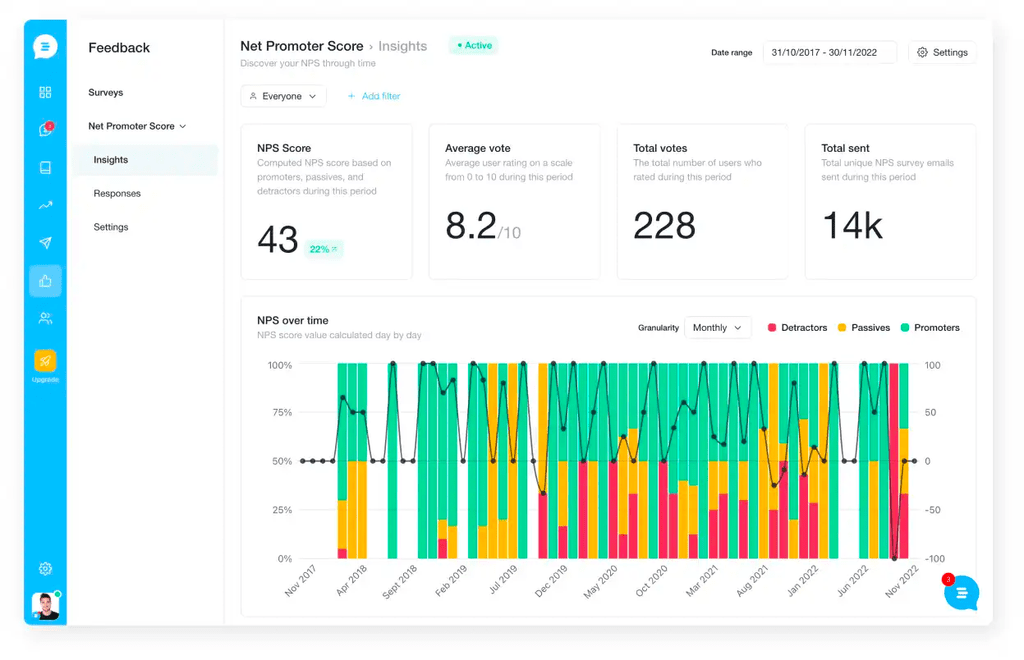
- Customer Experience Score surveys. This helps you identify how much effort a customer needs to put in to use your product.
- Various in-app surveys. Provides insight on a vast number of subjects, including feature relevancy to a user, pricing comparisons, market fit, customer personas, and more.
- Customer reviews. Simply put, they measure how happy a customer is with your product or service.
Gathering feedback about customer experience can help you to improve your business, products, and many different processes throughout your company. For example, sending customer feedback surveys asking how easy users find the signup and onboarding process accomplishes several things:
- Highlights any kinks in your system
- Shows customers you care about their experience with you
- Gives customers the opportunity to share their views
- Helps generate ideas for improvements
Types of Customer Experience
- Onboarding Experience: A good onboarding experience will allow your customers to extract the greatest amount of value from your product. Onboarding can be as simple as asking new users to complete certain tasks, having a self-service help center available, or providing a demo to get things started. We’re personally big fans of Dropbox’s ‘Dropbox Mastery’ onboarding sessions, where users complete simple tasks to become more familiar with the software.

- Product Experience: This one focuses on the customer journey within a product and how easily users are able to complete their objectives. It mostly comes down to product design and ease of use. This is somewhere HotJar excels, as website recording and heatmap software can have lengthy setup times. Hotjar, however, can be installed in under 10 minutes, meaning users can start collecting usable data quickly.
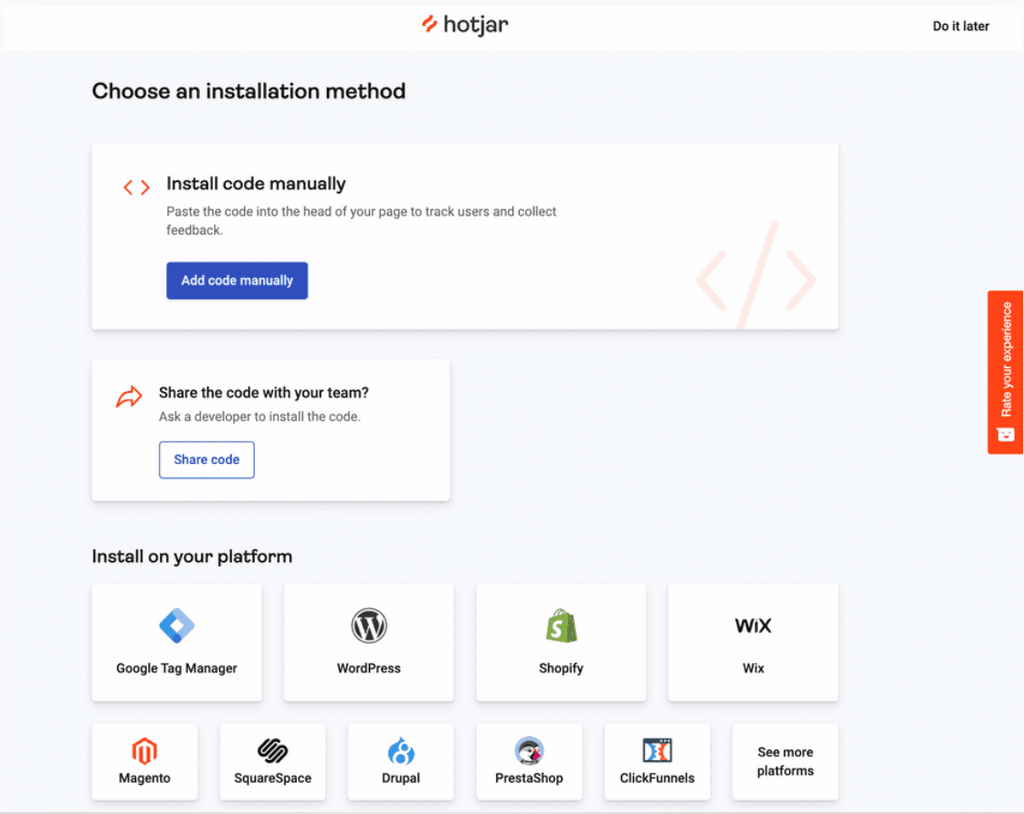
- Customer Support Experience: Remember how we said customer support and experience can be related? This is exactly what we mean. For the moments that your users need a little more assistance, you need to provide excellent support that answers any question and resolves all issues. This can come in the form of AI chatbots to help resolve simple customer issues, a help desk, live chats, and more. Spotify is a good example here, as they offer omnichannel support across a variety of platforms, even on social media!

Key Differences Between Customer Service and Customer Experience
Holistic Experience vs. Specific Interaction
The most prominent difference between customer service vs. customer experience is the nature of the interaction between customer and brand:
- Customer experience: This encompasses the entire journey of the customer, from the very first encounter to the time you part ways. It’s essentially a look at the entire funnel and every touchpoint throughout. Because of this, the customer has direct and indirect interactions with multiple departments, including marketing, sales, and technical support.
The marketing department, for example, influences the customer experience with its social media posts, paid ads, and blog content. The sales department, on the other hand, might discuss the best solutions for the customer. Finally, technical support might fix any technical issues the customer has with the software. In this way, the customer experience can be described as ‘holistic’.
- Customer Service: Customer service forms a part of the customer experience. It’s one type of touchpoint in the entire journey. The interaction is specific and always direct because it refers to solving an issue or answering a question. Customer service does not reflect how easy the customer finds the software to use, for example. It will, however, be influenced by how well a customer service rep explains how to use the software.
Proactive vs. Reactive
Customer service is proactive, meaning that a business does something to impact the customer. This could be talking them through how to use a specific feature, answering a question about the pricing structure, or sending an onboarding pack with information about how to get up and running. In all these examples, the company is actively doing something.
The customer experience, on the other hand, is reactive. It’s the customer’s reaction to different factors throughout the business and how they perceive the brand, product, and the way they’ve been treated during their interactions with the company. It doesn’t refer to doing something or not doing something. Rather, the impact your actions have on a customer.
If, for example, you’re a SaaS company, but your web pages are very slow to load, this will impact the customer experience. Not only will it be quite annoying waiting for pages to load, but it also doesn’t bode well to have a poor-performing website if you’re selling software that’s meant to be powerful, time-saving, or high-tech. Therefore, the customer’s perception of your brand, through this experience, might be that you don’t live up to your claims.
Relationship
The relationship between customer and brand is different when we talk about customer service vs. customer experience. Customer service is essentially a transaction of knowledge or assistance. The customer service rep is there to solve a problem or provide after-sale support when using a product.
Customer experience is a broader concept referring to all the aspects that make up a relationship. The point of providing a good customer experience is to encourage customer loyalty and reduce churn. The relationship, therefore, aims to be a long-term one rather than a one-off interaction. Customer service is a practical solution to a problem, while customer experience is all about nurturing over a period of time.
Success Metrics
Finally, the metrics for measuring success for customer service vs customer experience are different. It’s easier to determine the success of your customer service because you will have a specific thing that needs to be resolved. Customer experience, on the other hand, is the result of a collection of events. Therefore, if you have a high churn rate, it can be difficult to pinpoint the reasons why.
Customer experience metrics:
- Customer effort score: This refers to how much effort a customer has put into using your product. If they gave up pretty quickly, you might determine they found it difficult or not very useful. Customerly has a customer effort score survey template that you can use to gather customer feedback.
- Customer retention rate: Your customer retention rate is a strong indication of the overall customer experience of dealing with your brand. It’s the percentage of customers you retain over a certain period of time. Your retention rate can help you with sales and revenue forecasts and knowing when to scale your business further.
- Churn rate: If your customers are dropping like flies, you can be pretty certain your customers aren’t getting the experience they expected. A feedback survey can be useful here, too, to determine why your customers are unsubscribing or not renewing their contracts. This could be any number of reasons, like poor value for money or lack of support.
Customer service metrics:
- Customer satisfaction score: After interacting with you, whether through live chat or email, send the customer a short survey to assess their satisfaction. You can ask whether their issue had been resolved, how polite the rep was, and how satisfied they were with this experience.
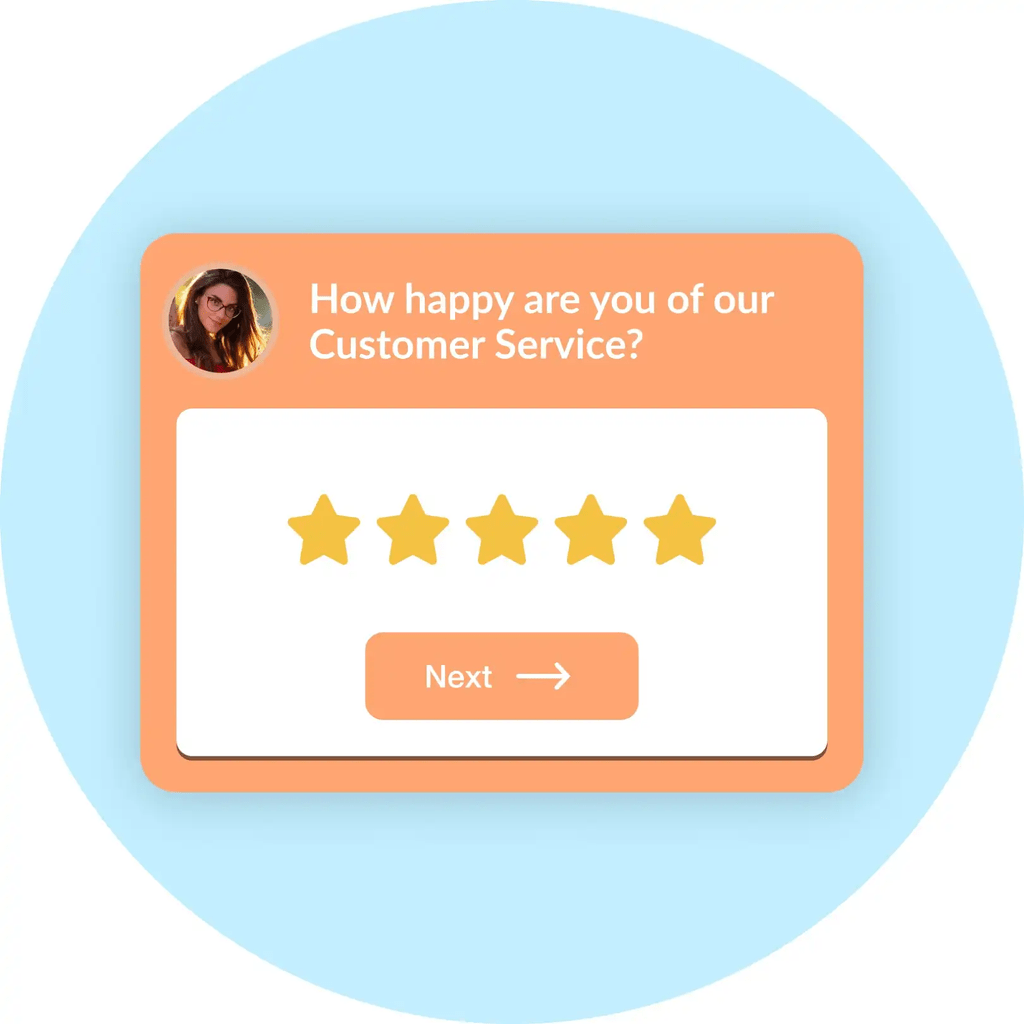
- Resolution time: The resolution time of customer service interactions will vary depending on the complexities of the issue. Generally speaking, you don’t want your customers to have big, complex issues while using your software or deciding whether to sign up. If you get a lot of time-consuming issues, you might conclude that you’re not explaining something well enough on your website.
- Average first response time: Your average first response time will indicate whether your level of customer service is acceptable. Chatbots can help considerably here. You install an AI chatbot on your website to answer basic queries or direct customers to the appropriate online resources. For more complex issues, your chatbot can connect the customer to a human.
Customerly Can Enhance Customer Service and Customer Experience
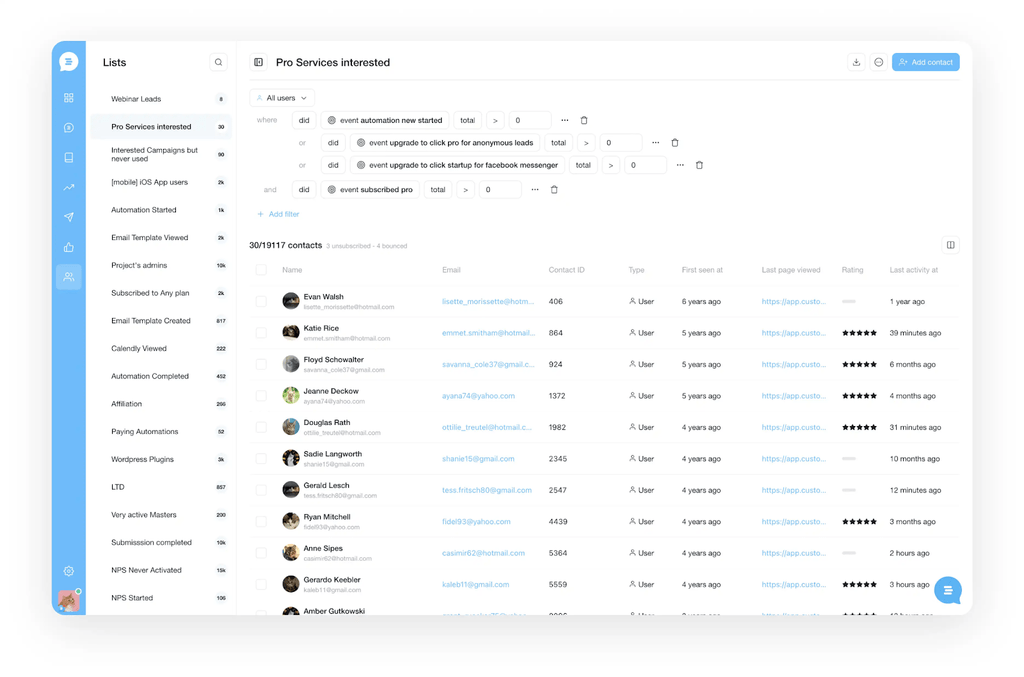
Customerly can help you build your relationships with customers with detailed metrics, live chat, and automated marketing workflows. Our customer service software bridges the gap between you and your customers by allowing you to be on hand whenever they have a query, a favored feature among our clients, Fatture in Cloud. Customerly nurtures your leads by automatically sending messages to customers when a predetermined action is performed, such as upgrading their subscription or submitting a form.
Here’s what you can expect from Customerly:
- Nurture your leads with personalized messages
- Conversational AI to give the best answers to FAQs
- Automate your processes so your marketing runs on autopilot
- Get more leads by encouraging interactions
- Segment your audience and target different segments
This is not an exhaustive list. Check out our Features Highlights to discover our most-loved features.
Conclusion
Customer service vs. customer experience might sound similar. However, your strategies for enhancing both sometimes require different approaches. Be sure to use the appropriate metrics to measure your company’s success rate for each, and take advantage of robust, comprehensive tools to further your efforts.
Customerly is an all-in-one customer service software that makes it easier to improve both customer service and customer experience. Keep on top of all your customer interactions with our AI-powered help center and use performance data to improve your processes. Sign up for a free trial today.
